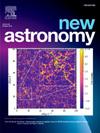WGAN-based molecular clumps generation
IF 2.1
4区 物理与天体物理
Q2 ASTRONOMY & ASTROPHYSICS
引用次数: 0
Abstract
In this paper, a new molecular clumps generation algorithm based on the Wasserstein Generative Adversarial Network (WGAN) is investigated for the problem that the simulated molecular clumps generated by the traditional Gaussian model have a large difference from the measured clumps. The method first generates position–position intensity map of the clump using WGAN and then performs 3D expansion in the direction of the velocity axis using a Gaussian function containing weak noise, which ultimately generates 3D simulated molecular clumps in position–position–velocity (PPV) space. Semi-supervised molecular clumps validation algorithm (SS-3D-Clump) is utilized to validate the 3D molecular clumps data generated by the method, and the confidence level of them are above 0.999. Experimentally, it is proved that the new method can provide simulated clumps with morphology and intensity closer to the measured clumps. The simulated molecular clumps are used on the one hand to generate PPV data in combination with measured backgrounds for testing the performance of molecular clump detection algorithms; on the other hand, they can also be used to supplement the 3D molecular clump samples. Experiments have demonstrated that, if 30%–50% of the measured positive samples are retained in the VoxNet training set, and the rest are simulated clumps generated, the classification accuracy can also be guaranteed.
基于wgan的分子团块生成
本文针对传统高斯模型生成的模拟分子团与实测值存在较大差异的问题,研究了一种基于WGAN的分子团生成算法。该方法首先利用WGAN生成分子团块的位置-位置强度图,然后利用含弱噪声的高斯函数沿速度轴方向进行三维展开,最终生成位置-位置-速度(PPV)空间的三维模拟分子团块。采用半监督分子团验证算法(ss -3D- cluster)对该方法生成的三维分子团数据进行验证,置信水平均在0.999以上。实验证明,该方法可以提供更接近实际团块形态和强度的模拟团块。模拟的分子团块结合实测背景生成PPV数据,用于测试分子团块检测算法的性能;另一方面,它们也可以用来补充三维分子团样。实验表明,如果在VoxNet训练集中保留30%-50%的测量阳性样本,其余为生成的模拟团块,也可以保证分类精度。
本文章由计算机程序翻译,如有差异,请以英文原文为准。
求助全文
约1分钟内获得全文
求助全文
来源期刊

New Astronomy
地学天文-天文与天体物理
CiteScore
4.00
自引率
10.00%
发文量
109
审稿时长
13.6 weeks
期刊介绍:
New Astronomy publishes articles in all fields of astronomy and astrophysics, with a particular focus on computational astronomy: mathematical and astronomy techniques and methodology, simulations, modelling and numerical results and computational techniques in instrumentation.
New Astronomy includes full length research articles and review articles. The journal covers solar, stellar, galactic and extragalactic astronomy and astrophysics. It reports on original research in all wavelength bands, ranging from radio to gamma-ray.
 求助内容:
求助内容: 应助结果提醒方式:
应助结果提醒方式:


